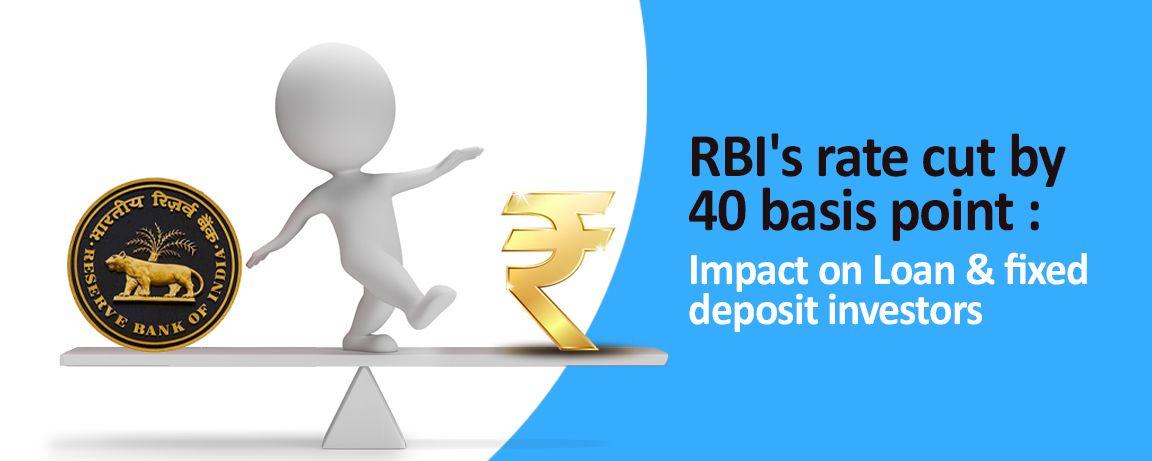Shaktikanta Das, governor of the Reserve Bank of India (RBI), announced a cut in key policy rates today (i.e., 22.05.2020). The rate cut came after the central bank advanced its scheduled monetary policy meet from the first week of June to 22 May, 2020.
It is good news for loan borrowers, especially those whose loans are linked to an external benchmark like the repo rate. However, for fixed deposit (FD) investors, this rate cut is likely to reduce the interest rates on deposits.
The repo rate has been cut by 40 basis points (bps). 100 bps = 1 per cent. The revised repo rate is now 4% and the reserve repo rate is 3.35%. The apex bank last cut rates in March 2020 in its advanced monetary policy review. In total, RBI has cut the repo rate by 115 bps since the beginning of the lockdown.
Impact on borrowers
The rate cut will reduce borrowers’ equated monthly instalments (EMIs) and will also make it cheaper to avail new loans.
Here’s an example of the impact on RBI’s rate cut on your home loan under SBI’s new external benchmark regime:
| Loan amount | Rs. 40 Lakhs |
| Repayment tenure | 30 years |
| Current rate of interest | 7.40% |
| Current EMI | Rs. 27,695 |
| New rate of interest | 7% |
| New EMI | Rs. 26,612 |
| Cut in EMI | Rs.1,083 |
Impact on existing borrowers
A. With loans linked to external benchmark
EMIs of borrowers whose loans are linked to an external benchmark, i.e., repo rate, treasury-bills, etc. can come down in the next 3 months because as per RBI’s circular dated September 4, 2019 on linking of interest rates of loans to an external benchmark, the rates have to be reviewed by banks atleast once every 3 months.
Therefore, the recent rate cut will lower the EMI of borrowers in the next 3 months. This is the third time RBI has cut its repo rate after the new lending rate regime became effective from 01.10. 2019.
B. With loans linked to the base rate or BPLR
Borrowers whose home loans are still linked to the base rate or BPLR (Benchmark Prime Lending Rate), should consider shifting to an external benchmark based loan as the new external benchmark loan regime provides better transmission of policy rates compared to the base rate and BPLR rate linked loans.
NirmalaSitharaman, the Finance Minister of India, recently announced in the Atmanirbhar Bharat Package the extension of credit linked subsidy under PMAY (PradhanMantriAwasYojana) till March 2021. Under this scheme, middle income group – I (MIG -I) having income between Rs. 6 lakhs and Rs 12 lakhs can avail interest subsidy of 4% whereas middle income group – II (MIG -II) having income between Rs. 12 lakhs and 18 lakhs can get an interest subsidy of 3%.
The recent rate cut will make the new loans further cheaper. However, when availing a loan linked to an external benchmark, make sure that you compare the spread and risk premium charged by the lenders over and above the external benchmark, to avail the benefit of the cheapest interest rate.
Also, some banks are offering loans that are linked to external benchmark that is not repo rate. In its report in April 2020, RBI mentioned that 6 banks are offering interest rates linked to treasury bills,CD rates, etc. instead of repo rate.
Keep in mind that when RBI will start to hike key rates, your interest rate will also go up in tandem. So external benchmark linked interest rate is likely to be more volatile than the MCLR linked rate.
Impact on FD investors
The latest rate cut will cause more trouble for FD investors, especially senior citizens who are dependent on this interest income. After the last rate cut by RBI in March, the country’s largest lender announced a decrease in the FD interest rate by up to 50 bps and the rates were further revised on 12.05.2020.
Currently, SBI’sone year fixed deposit is offering 5.50% interest rate.For senior citizens, the rate is higher by 50 bps, i.e., 6%.
Investors who are looking for fixed income avenues, may consider investing in RBI taxable 7.75% bonds, PM VayaVandanaYojana, andSenior citizens savings scheme. At present, these schemes are earning above 7% per annum.
